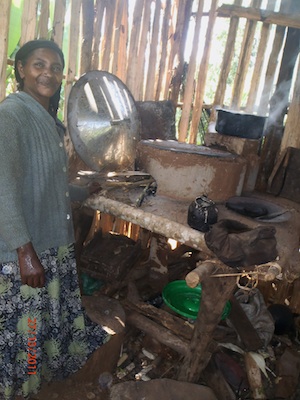Photo Gallery
 Kafa is the birthplace of wild coffee, Coffea arabica, where it has been consumed for more than 1,000 лет. There are now close to 5,000 wild varieties of coffee in this biodiversity hotspot. A unique coffee culture is deeply ingrained in the Ethiopian economy and history. This culture is a key element of the participatory forest management scheme created in the Kafa Biosphere Reserve to avoid deforestation and boost economic development.
Kafa is the birthplace of wild coffee, Coffea arabica, where it has been consumed for more than 1,000 лет. There are now close to 5,000 wild varieties of coffee in this biodiversity hotspot. A unique coffee culture is deeply ingrained in the Ethiopian economy and history. This culture is a key element of the participatory forest management scheme created in the Kafa Biosphere Reserve to avoid deforestation and boost economic development.
NABU (The German Nature and Biodiversity Conservation Union) and its partners have worked towards the preservation of these forests obtaining the establishment of the UNESCO Kafa Biosphere Reserve in June 2010 and implementing the project: “Climate Protection and Preservation of Primary Forests – A Management Model using the Wild Coffee Forests in Ethiopia as an Example“.
Проект достиг производство и распределение 11200 энергосберегающих печей жителям хотя совместными усилиями с Министерством энергетики. 70 безработной молодежи обучались организованы и оснащены и развернуты в 11 производство и 25 спутниковых сайтов.
The dependency on biomass energy: a driving force for deforestation
Only 40 лет назад, некоторые 40% of the Ethiopian land surface was occupied by forests. Сегодня, less than 3% remains, largely in the Kafa coffee biosphere reserve, which still boasts large areas of mountainous afromontane cloud forest. The forest ecosystem makes an important contribution to the livelihoods of people in the area. It provides wild coffee, valuable spices and honey from wild bees. It also contains some 25 million tons carbon in above-ground biomass. Некоторые 600,000 tons of carbon could be removed from the atmosphere annually through natural forest growth – if the forest remains intact. But it is endangered due to clear-cutting for smallholder agriculture and industrial coffee and tea plantations, and the intensive use of biomass.
Эфиопия в настоящее время обслуживает 96 процентов своей потребности в энергии использования биомассы. В связи с этим многие семьи удовлетворения их спроса на вырубку деревьев образуют имеющиеся природные леса / Леса и кустарники земли. Эта ситуация была названа в числе одной из движущих сил для вырубки леса. Как и в других частях страны люди Кафы в основном используют изделия из древесины для пожарных. Дров исходит из близлежащих лесов. Кроме того, биотопливо в основном используется неэффективно. Это имеет прямое отношение с доходов и бюджета времени. Чем больше неэффективно используется древесина больше женщин и детей времени потратит на сбор дров.
There is no electric power plant in the Biosphere Reserve. Electricity is supplied only to a few areas of the reserve by an external hydro-power plant.
Energy-efficient stoves and other renewable energy sources
Among the activities carried out by NABU’s Climate and Forest Project to mitigate the impact of meeting energy requirement using biomass, there are two main lines of action: promotion of community plantations with fast-growing tree species as fuel wood and introduction of efficient wood-burning stoves.
In this last case, the target of the project is to introduce energy-saving stoves to the communities in Kafa Biosphere Reserve. 11200 stoves were distributed until September 2012. The plan says that 10000 stoves will be distributed to households with high wood consumption by September 2012. Новая методика эти печи не только уменьшает количество древесины необходимым для приготовления пищи на половину, Это также экономит леса, Время для пользователя и производит меньше дыма и огня. The stoves are therefore a source of great relief to the people and the forest and have been very well received.
Производить и распространять печей NABU тесно сотрудничает с Кафа зоны Департамента водного, Горнорудной промышленности и энергетики. В рамках этого сотрудничества 70 молодых безработных прошли подготовку в качестве печи поддерживается производителями и начать их производство бизнес.
In collaboration with GLEN (Global Education Network of Young Europeans) a study has been conducted on alternative energy sources where coffee husk briquets, биогаза и солнечной появился как одинаково актуальны.
Annually, in the area of biosphere reserve, о 100 t of coffee husk is produced. This represents an ideal material for briquetting. But not only the coffee husk: dry leftovers from other crops processing (e.g. maize, sorghum etc.) can be used as well. Another source is biogas production, based on two big potential sources: cattle dung and coffee pulp.
The Kafa Water, Mining and Energy Department has started to implement some renewable energy programs in its “5 years strategic plan” – starting from 2011. 450 PV solar panels were distributed until September 2012.
Lessons learned and potential replicability
The acceptance of wood-saving stoves is very high and they are easily adapted by users. Within this context, local communication and education are essential. The importance of the training programme for young people to help them expand their own knowledge of climate and forest protection is recognised. In turn, they can share this knowledge and raise the awareness of other members of their communities.
With regard to energy, solar power has a high potential and there are multiple benefits of using solar energy in the area. But before installing new panels it is necessary to prepare and train technical staff that will work in the zone.
The successful results of this project may have a significant impact on other areas of the region with similar characteristics and needs. This would be the case of Yayu Biosphere Reserve, also in Ethiopia, and of other similar areas, like the Ituri region in the Democratic Republic of Congo.

















